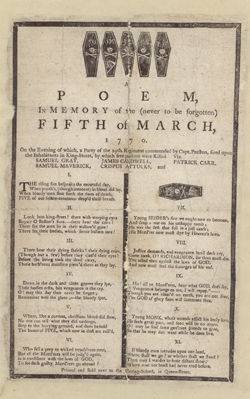“Voices from the Boston Massacre” Exhibit at M.H.S.
The Massachusetts Historical Society has opened a new exhibit called “Voices from the Boston Massacre,” displaying documents and artifacts from its collection illuminating that Sestercentennial event of 5 Mar 1770.
The exhibit includes trial notes and letters from the collections of such attorneys as John Adams, Robert Treat Paine, and Samuel and Josiah Quincy, Jr. There’s a full series of Massacre engravings by Henry Pelham, Paul Revere, and the artists who copied them. We can see the musket balls that Edward Payne dug out of his doorway after he was wounded in the arm. We can read parts of the newspaper reports, orations, and memoirs of the event.
One document new to me is the recently acquired handwritten memoir of Julia Bernard Smith, daughter of Gov. Francis Bernard. He left Massachusetts in August 1769, but his family remained behind until December 1770, in part because the children were still in school.
Later in life, Smith wrote: “Captain [Thomas] Preston had performed at my Father’s Concerts and was well known to us.” I knew Preston was generally well regarded, but I had no idea he was musical.
This exhibit holds personal meaning for me. Twenty years ago, I was drawn into the study of Revolutionary Boston through the figure of Christopher Seider, the young boy killed eleven days before the Massacre by Customs officer Ebenezer Richardson.
As I wrote back here, I spent years looking for a broadside that a newspaper said Christopher had in his pocket when he died, and I finally found it in the M.H.S. catalogue. Now that broadside is in a display case near the beginning of the exhibit, illustrating Christopher’s importance in the events that followed. And the label cites my work identifying its significance.
There are also a couple of video displays in this exhibit. One shows actors reading various witnesses’ accounts of the shooting (or, in the case of Charles Bourgate, what he claimed was his account). Another shows historians speaking about the event from Serena Zabin and Hiller Zobel down to myself.
The M.H.S.’s “Voices from the Massacre” website features online resources about the period for researchers and educators. Folks can visit the exhibit at 1154 Boylston Street in Boston every Monday through Saturday from 10:00 A.M. to 4:00 P.M., and as late as 7:00 P.M. on Tuesdays. It will be up through the Massacre anniversary until June 2020.
Speaking of the Massacre, I’ll be speaking of the Massacre with Bradley Jay on WBZ radio’s Jay Talking Show—what led up to the confrontation on King Street, how it happened, and why it mattered. That conversation will run from midnight to 1:00 A.M. on the morning of Tuesday, 12 November. If our chat is particularly interesting, it will become one of the show’s podcasts.
The exhibit includes trial notes and letters from the collections of such attorneys as John Adams, Robert Treat Paine, and Samuel and Josiah Quincy, Jr. There’s a full series of Massacre engravings by Henry Pelham, Paul Revere, and the artists who copied them. We can see the musket balls that Edward Payne dug out of his doorway after he was wounded in the arm. We can read parts of the newspaper reports, orations, and memoirs of the event.
One document new to me is the recently acquired handwritten memoir of Julia Bernard Smith, daughter of Gov. Francis Bernard. He left Massachusetts in August 1769, but his family remained behind until December 1770, in part because the children were still in school.
Later in life, Smith wrote: “Captain [Thomas] Preston had performed at my Father’s Concerts and was well known to us.” I knew Preston was generally well regarded, but I had no idea he was musical.
This exhibit holds personal meaning for me. Twenty years ago, I was drawn into the study of Revolutionary Boston through the figure of Christopher Seider, the young boy killed eleven days before the Massacre by Customs officer Ebenezer Richardson.
As I wrote back here, I spent years looking for a broadside that a newspaper said Christopher had in his pocket when he died, and I finally found it in the M.H.S. catalogue. Now that broadside is in a display case near the beginning of the exhibit, illustrating Christopher’s importance in the events that followed. And the label cites my work identifying its significance.
There are also a couple of video displays in this exhibit. One shows actors reading various witnesses’ accounts of the shooting (or, in the case of Charles Bourgate, what he claimed was his account). Another shows historians speaking about the event from Serena Zabin and Hiller Zobel down to myself.
The M.H.S.’s “Voices from the Massacre” website features online resources about the period for researchers and educators. Folks can visit the exhibit at 1154 Boylston Street in Boston every Monday through Saturday from 10:00 A.M. to 4:00 P.M., and as late as 7:00 P.M. on Tuesdays. It will be up through the Massacre anniversary until June 2020.
Speaking of the Massacre, I’ll be speaking of the Massacre with Bradley Jay on WBZ radio’s Jay Talking Show—what led up to the confrontation on King Street, how it happened, and why it mattered. That conversation will run from midnight to 1:00 A.M. on the morning of Tuesday, 12 November. If our chat is particularly interesting, it will become one of the show’s podcasts.


No comments:
Post a Comment